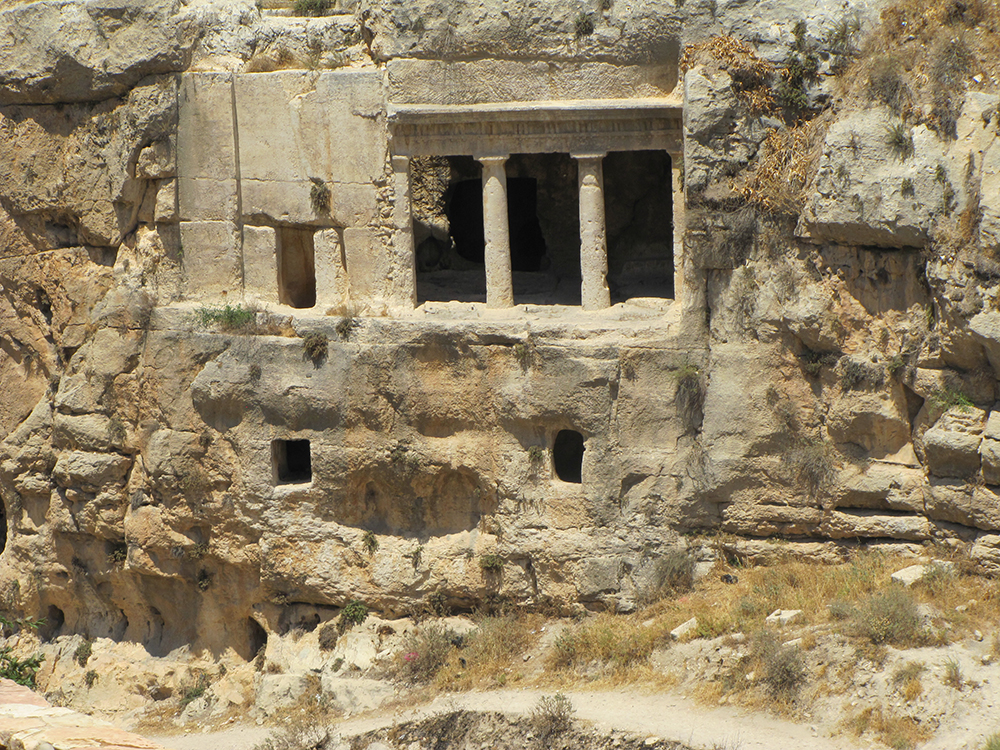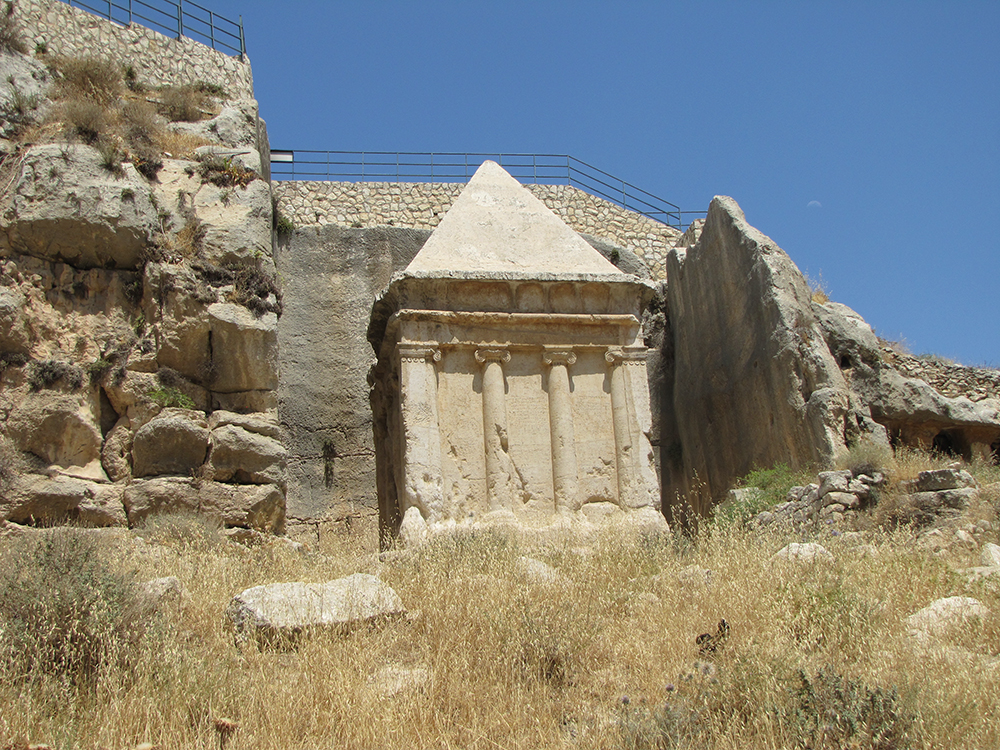
Section D Maccabees and Hasmoneans 167- 40 BC, Revolt & Independence
Chapter 32 - Tombs in the Kidron
Since the Jews would not bury their dead inside the city walls, Jerusalem is surrounded by tombs. There are tombs to the west in the Hinnom Valley, tombs to the south where the Hinnom and Kidron Valleys meet, tombs to the north of today’s Old City walls and, of course, tombs to the east in the Kidron Valley where the Messiah is to appear to raise the dead, judge mankind and enter his Temple on Mount Moriah. During the days of the Hasmoneans, Hellenistic culture influenced the building of elaborate tombs, and this practice continued into the days of the New Testament. Eight hundred tombs from the time of Herod have been discovered within a 3 mile radius around the city. Jesus was buried in a tomb that was being cut for a Sanhedrin member outside the city walls to the west.
The tombs in the Kidron Valley shown in the photos below were present in the days of Jesus, who would have walked past them many times and constantly viewed them whenever his eyes scanned the Kidron Valley or the Mount of Olives. He even spoke about them in the Gospels, calling them “beautiful” when he addressed the religious leaders on the Temple Mount:
Woe to you, teachers of the law and Pharisees, you hypocrites! You are like whitewashed tombs, which look beautiful on the outside but on the inside are full of dead men’s bones and everything unclean.
- Matthew 23:27

Three tombs are visible in this photo taken from the eastern wall of the Temple Mount. 1) To the left is a tomb with two Doric columns identified as belonging to a family of priests by an inscription inside the tomb that mentions the "sons of Hezir”; 2) In the middle is a tomb known as Zechariah’s Tomb (about 30 people in the Bible are called Zechariah); 3) To the far right, south of "Zechariah’s Tomb,” is an unfinished tomb cut in the rock.

Here is a close up of the tomb belonging to a family of priests named Bene Hezir (or, sons of Hezir). 1 Chronicles 34:1 and 15 mention a priest named Hezir from the line of Aaron serving in the days of David. An inscription written in Hebrew found on the tomb says: This is the tomb and the monument of Alexander, Hanniah, Yo’ezer, Judah, Simon, Johanan, the sons of Joseph son of Oved. Joseph and Eliezer sons of Hanniah – priests of the Hezir family. The inscription mentions a monument that may have been located to the left of the tomb entrance on the wall.

This tomb, known as Zechariah's Tomb, was cut during the life of Jesus.
Zechariah's Tomb is a cube cut out of the rock with Ionic pilasters and a pyramid top. "A" in the photo marks a corridor with steps that provides access to the tomb of the Hezir family to the left. "B" marks a small chamber cut under the base to serve as a tomb. To the right (south) is a tomb that was never finished. This monument (called “Zechariah’s Tomb”) may have been built to honor those who would be buried in the unfinished tomb to the south.


An unfinished tomb cut in the rock to the south of "Zechariah’s Tomb ".
This tomb is just a little further north of the three previously mentioned tombs in the Kidron Valley. It was constructed during Jesus’ lifetime. Today it is traditionally called the Pillar of Absalom or Absalom’s Monument. The Bordeaux Pilgrim referred to it as the Tomb of Hezekiah in 333 AD. It was first associated with Absalom by Benjamin of Tudela in 1170 because of 2 Samuel 18:18. The actual person or family for whom this tomb was prepared is unknown. The architectural style includes both Egyptian and Greek influences, which would have come from the two kingdoms that dominated Judea between 300-100 BC. The Egyptian influence came from the Ptolemys of Egypt, and the Hellenistic style from the Seleucids, who were Greeks ruling in Syria. The lower square is cut from the bedrock. It is topped with a finely-cut circular stone with a conical top that was cut from one single stone. Directly to the left of this tomb is an eight-chambered catacomb with well-preserved carved stone. The catacomb is called the Cave of Jehoshaphat. The Pillar of Absalom may have been a monument for the burial chambers in the Cave of Jehoshaphat, cut into the cliff behind it. There are two inscriptions in this monument. A two-line inscription above the door is from around 400 AD that says: “This is the tomb of Zachary, martyr, most holy priest, father of John the Baptist.” A later inscription can be seen to the right of the door but only the word “simon’ can be made out. Neither inscription is historically valuable or accurate.


This tomb is further south under the village of Silwan and is known as the Tomb of Pharaoh's Daughter. This tomb was cut during, or right after, the Hasmonean age but is unidentified. Originally this tomb, which looks like a small house, was topped with a pyramid roof cut from a single rock. Sometime after 700 AD the pyramid roof was cut up into blocks to be reused. The process caused great damage to the tomb. More damage was caused by a hermit who used this tomb as a home. There was an ancient Hebrew inscription in the upper left corner of the entrance, but now only two letters remain. The rest of the inscription was destroyed when the hermit widened the doorway.